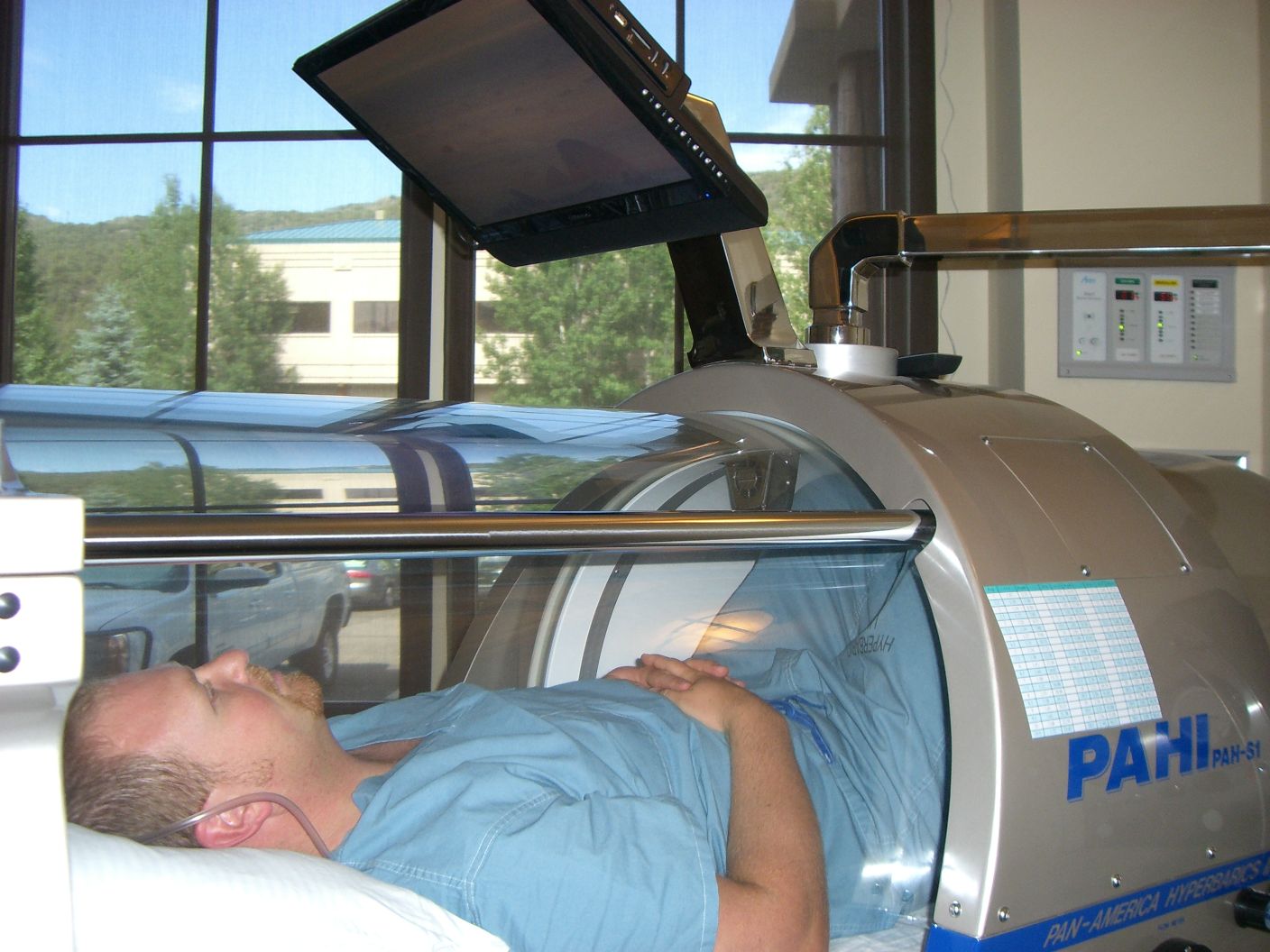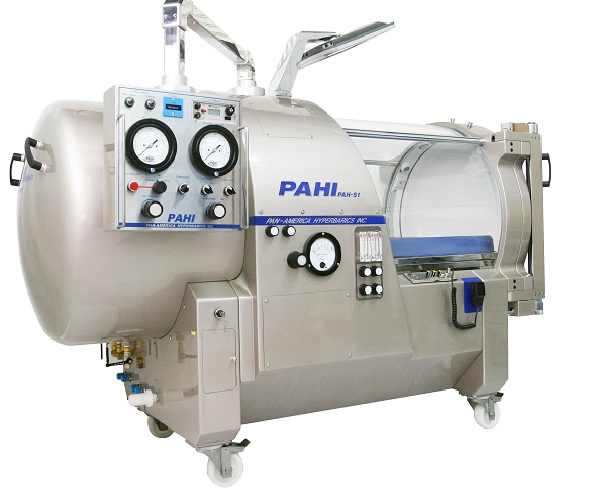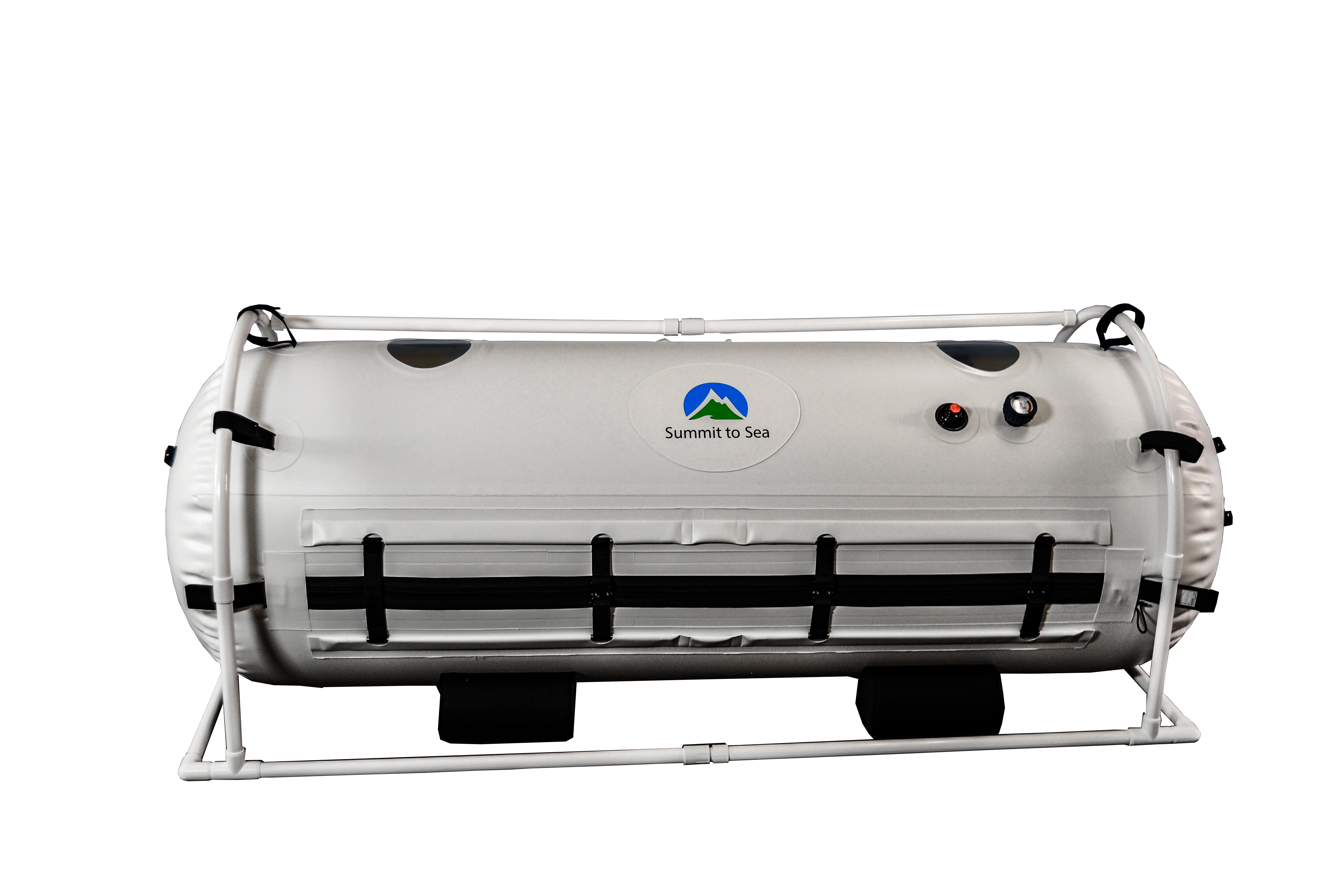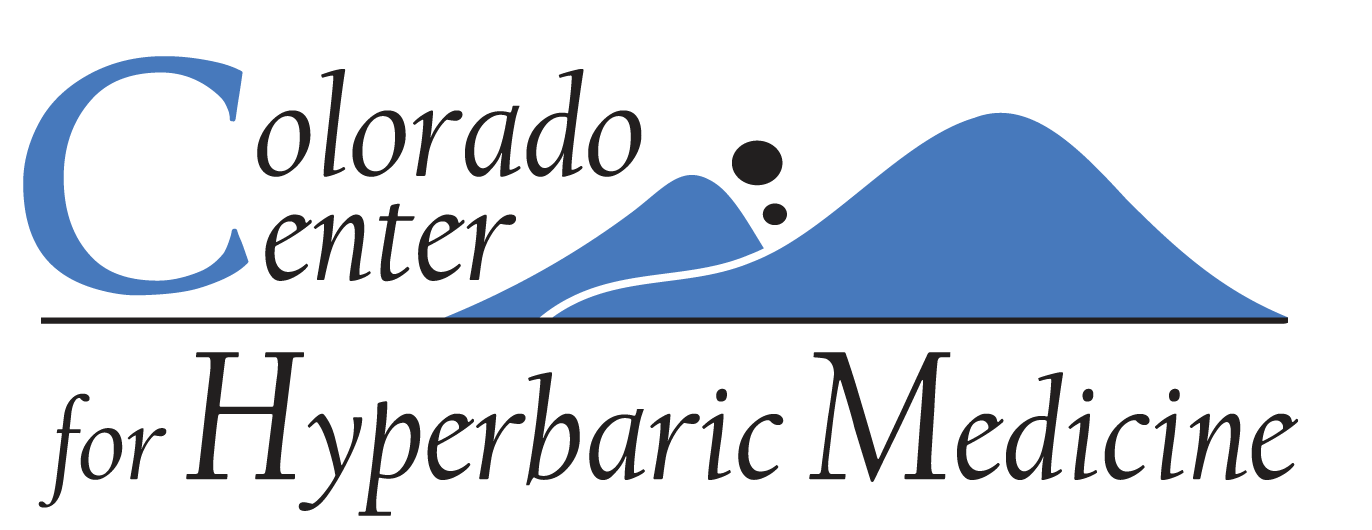What is Hyperbaric Oxygen Therapy (HBOT)
Hyperbaric Oxygen Therapy, abbreviated HBO or HBOT, is a unique medical treatment that uses high dose oxygen to speed and enhance the body’s natural ability to heal. Oxygen is dissolved into all of the body’s fluids, the plasma, the central nervous system fluids, the lymph, and the bone, carrying it to areas where circulation is diminished or blocked. The increased oxygen can greatly enhance the ability of white blood cells to kill bacteria, reduce swelling, and allow new blood vessels to grow more rapidly into the affected areas.
In many cases, such as circulatory problems, non-healing wounds, and strokes, adequate oxygen cannot reach the damaged area and the body’s natural healing ability is unable to function properly. HBOT provides this extra oxygen naturally and with minimal side effects.
HBOT has been a mainstay treatment for severe conditions such as non-healing skin ulcers, carbon monoxide poisoning, decompression sickness, and as an off-label treatment for TBI for the past few decades. Almost every major hospital is equipped with these rather large compression medical grade chambers that can take patients to depths of 3 atmospheres or more.

Hyperbaric Oxygen Therapy (HBOT) Benefits
- Increases tissue oxygenation in the brain*
- Slows and reverses hypoxic induced apoptosis*
- Restores blood supply to the compromised region of the brain*
- Generates new capillary networks (neovascularization)*
- Aids other regenerative therapies, such as PRP and stem cell therapies*
*Results may vary; no guarantee of specific results
%
Oxygen

Benefits for Traumatic Brain Injury
Many studies show the effectiveness of HBOT in improving brain function and quality of life in mild traumatic brain injury (mTBI) patients suffering chronic neurocognitive impairments. The common conclusion is that HBOT can induce neuroplasticity, leading to repair of chronically impaired brain functions and improved quality of life in mTBI patients with prolonged post-concussion syndrome (PCS) at late chronic stage. Studies also reveal that HBOT can reduce cognitive impairment related to memory performance and connectivity using functional MRI.
The science behind HBOT for TBI patients is vast.[1] It has been shown that breathing 100% oxygen at increased atmospheric pressures allows the body to absorb about 10-15 times its normal supply of oxygen. This “high dose” oxygen, stimulates the growth of neuronal tissue, bone and blood vessels, reduces inflammation, and mobilizes stem cells.
Two hours of HBOT at 2 ATA doubles the patient’s own circulating stem cells; 40 hours of HBOT at 1.5-2.0 ATA increases circulating stem cells to 8-fold (800%). This stem cell increase results from an increase in nitric oxide in the bone marrow. Nitric oxide stimulates enzymes that mediate stem/progenitor cell release.
The benefits of hyperbaric oxygen therapy on CBF can be seen in the following nuclear SPECT scan.[2]
Figure 1. Volume rendered Brain SPECT perfusion maps of Example 1, a 51-year-old woman from the treated group suffering mTBI that had occurred 2 years prior to inclusion in the study.
While reduction of inflammation, tissue growth, angiogenesis are all important aspects of HBOT’s beneficial effects for TBI patients, the stem cell release has been the particular focus at TBI Therapy. In the U.S., stem cell clinics do not have the privilege, per FDA regulations, to “grow up,” culture autologous human stem cell outside the body for 3 weeks as is allowed in more stem cell friendly countries. For stem cell practitioners, HBOT solves this issue by allowing the body to upregulate and send stem cells to the most needed areas of healing.
This stem cell upregulation fact has been seen clinically in a case study with a patient who has used both medical grade and home HBOT chambers extensively since his TBI in August 2012. In March 2015, Dr. Michael Brown, MD performed a procedure to harvest autologous platelet derived cells from this patient and found that he had 3.5 billion cells per mL of plasma collected. Dr. Brown and his colleagues thought the cell counter machine was incorrect because the patient’s cell counts were over 23x the average patient’s counts (which is normally 150 million cells).
[1] https://tbitherapy.com/tbi-protocol-references/
[2] Boussi-Gross, R., Golan, H., Fishlev, G., Bechor, Y., Volkov, O., et al. (2013) Hyperbaric Oxygen Therapy Can Improve Post Concussion Syndrome Years after Mild Traumatic Brain Injury – Randomized Prospective Trial. PLoS ONE 8(11): e79995. doi: 10.1371/journal.pone.0079995.
“The brain is in a metabolic crisis in a concussion, potassium ion from inside the cell going extracellular, calcium ions going intracellular, neurotransmitters widely released in a chaotic manner. It takes energy to pump that potassium back, put the neurotransmitters back on so the cell can function.”
HBOT Protocol for TBI
In the past several decades, Dr. Paul Harch, MD has helped to further develop and standardize the protocols for HBOT’s use for the treatment of TBI. The primary protocol has been to treat the TBI patient (mild, moderate, severe) with the same 40 treatment protocol at 1.5 ATA for 1 hour at depth. Nonmedical home chambers have been scorned and discounted as having any value. This one-size fits all approach has been adopted and utilized by HBOT clinics around the US, which positive success for the patients treated, but limited by the scope of patients that can devote the time (6-8 weeks) and financial resources ($5000-8000) to commit to this protocol. And, in fact, HBOT alone, even over 40 treatments, may not resolve the long-term post-concussion sequela experienced by TBI patients. Finally, most insurance plans and government organizations balk at the idea of paying for this type of long-term therapy for TBI patients. This battle between science and the business of treating TBI by medical insurers and other third parties has led to a stalemate and ultimately, the a failure for any practitioners to incorporate even shorter bursts of HBOT or home HBOT chambers into their treatment of TBI.
At TBI Therapy, we have sought to change the fundamentalist protocol of 40 HBOT treatments for all but the most severe TBI patients. We allow the patients to utilize their own home HBOT chambers at 1.3-1.4 ATA before coming to get medical HBOT treatments at 1.5-2.0 ATA. TBI Therapy has developed 3-10 day programs for patients with their own chambers (or milder brain injuries or who have already completed 40 HBOT treatments) that incorporate all of the discussed modalities of therapy including HBOT, cranial osteopathy, nasal specific, intranasal therapies, ketogenic nutrition, IV nutrition, and binaural rhythms. Every patient who utilizes this multi-modal TBI Therapy treatment gains some form of benefit, even with just a small number of HBOT sessions. Patients report sleeping well, having more mental energy, more clarity, more physical energy, and improved memories.
It is theorized that multi-modal therapy for TBI (including antioxidant IV nutrition and IN glutathione) also allows patients to sustain deeper dives beyond 1.5 ATA. Part of the rationale for keeping patients at 1.5 ATA is the fact that the patients may suffer from more oxidative stress with higher pressures. As one would do with an athlete, using appropriate nutrition can protect against this oxidative stress and improve the overall benefit of HBOT therapies for the TBI patient.
Also, thinking of HBOT as akin to athletic training for the brain injured patient, it has been found that “altobaric training” may be more effective than monobaric training. Altobaric training means that the patient is not simply kept at 1.5 ATA (or any consistent pressure) for more than a short amount of time (10 minutes or less) so that the body and brain have to adapt to changing pressures. This is kind of like interval training for an athlete. A typical altobaric HBOT protocol might include spending 10 minutes at each depth: 1.4, 1.6, 1.8, 2.0, 1.8, 1.6, 1.4 ATA over a 1.25 hour session. Some studies suggest a continued variation in pressure.[1]
Other protocols and adaptations include hypoxic training before going into the HBOT chamber. Dr. Adam Breiner reports that he has patients exercise on a bicycle for 15 minutes before getting into the chamber using a mask that makes the patient breathe air with less oxygen.[2] Dr. John Hughes, DO reports that simply having the TBI patient hold his or her breath for a minute while in the chamber is effective. Even elevating the lower extremities to improve CBF to the brain can be an effective way to help some patients.
[1] https://www.ncbi.nlm.nih.gov/pubmed/11434218
[2] Hypoxico is a great resource for getting a hypoxic chamber or mask to help patients gain the maximum benefit of HBOT. http://www.hypoxico.com/ Note: TBI patients may only be able to handle a certain amount of hypoxic stress so gauge your treatments accordingly.
Safety and Side Effects
The biggest, most obvious danger of HBOT is the fact of being in an oxygen saturated environment. It is key for patients to remove all clothing that may create a spark, all jewelry, all perfumes, hair sprays, and all lotions. 100% cotton is the only clothing acceptable in medical grade chambers, provided most often as scrubs. Other not-so-obvious precautions include patients with sinus issues, claustrophobia, dental work, pulmonary fibrosis, or cardiac anomalies. TBI patients with V-P shunts are usually okay as long as the shunt is working correctly.
Patients have reported sinus issues, barotrauma, and agitation as the biggest side-effects of treatment. Most TBI patients do quite well and enjoy the HBOT dives. Having an excellent technician is an absolute. Kirk Hartley from the Colorado Center for Hyperbaric Medicine is one of the best –http://www.cohyperbarics.com/.
At-Home Chambers
Hyperbaric “soft” chambers can be purchased for at-home use. These chambers offer similar benefits one can find at a HBOT center, but may need to put more hours in. This can save you money and time from traveling and visiting a HBOT center. At-home chambers come in various sizes, shapes, and costs.
Contact our office if you are interested in purchasing an at-home chamber by calling 970-927-0466 or emailing us at admin@aspenintegrativemedicine.com.

Hyperbaric Oxygen Clinics in Colorado
The Colorado Center for Hyperbaric Medicine
We work closely with The Colorado Center for Hyperbaric Medicine – the premiere institute for hyperbaric oxygen therapy and natural healing in the rocky mountains. Our partner, Kirk Hartley owns, manages, and operates this high class facility 20 minutes from Aspen, Colorado. If patients choose to visit our Basalt clinic, they will receive the utmost care from Kirk during their HBOT sessions. Learn more about his clinic at cohyperbarics.com

Rocky Mountain Hyperbaric Institute
We recommend visiting the Rocky Mountain Hyperbaric Institue if you are near Boulder, Colorado. https://rockymountainhbot.com/
Pikes Peak Hyperbaric Medicine
Located in Colorado Springs, Pikes Peak Hyperbaric Medicine offers HBOT for a myriad amount of conditions. Check out http://www.pikespeakhyperbaricmedicine.com/

